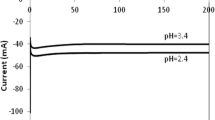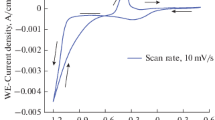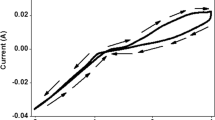Abstract
Ternary CoFeCu films, relating their magnetic and magnetoresistance properties with film composition, surface morphology and the corresponding crystal structure, were investigated in terms of different deposition potentials in electrodeposition. The films were grown on polycrystalline titanium substrates. The potentials were obtained from cyclic voltammetry and the current–time transients were also recorded to control the growth of proper films. From the structural analysis by X-ray diffraction, all films had a face-centred cubic structure and the calculated grain size increased with increasing deposition potential. The film compositions by energy dispersive X-ray spectroscopy revealed that the Co, Fe and Cu contents varied and the scanning electron microscope images disclosed that the film morphologies changed as the deposition potential changed. The saturation magnetization was high and coercivity was low at high deposition potential. The easy axis of magnetization was parallel to the film plane for all films. All films showed anisotropic magnetic resistance and their magnitudes were between 3.2 and 3.8 %. The variations in magnetic and magnetoresistive properties related to the microstructure were attributed to the variation of the film contents caused by deposition potential.






Similar content being viewed by others
References
D. Jiles, Introduction to Magnetism and Magnetic Materials (Chapman and Hall, London, 1991)
É. Du Trémolet de Lacheisserie, D. Gignoux, M. Schlenker, Magnetism: Materials and Applications (Kluwer Academic Publishers, Springer, 2005)
K. Tobari, M. Ohtake, K. Nagano, M. Futamoto, Influence of layer thickness on the structure and the magnetic properties of Co/Pd epitaxial multilayer films. J. Magn. Magn. Mater. 324, 1059–1062 (2012)
P.J. Sadashivaiah, T. Sankarappa, T. Sujatha, R.R. Santoshkumar, R. Rawat, P. Sarvanan, A.M. Bhatnagar, Structural, magnetic and electrical properties of Fe/Cu/Fe films. Vacuum 85, 466–473 (2010)
A.V. Davydenko, Y.P. Ivanov, L.A. Chebotkevich, Magnetic and magnetoresistive properties of epitaxial Co/Cu/Co trilayers on Si(111). J. Magn. Magn. Mater. 324, 1248–1252 (2012)
R. Fathi, S. Sanjabi, Electrodeposition of nanostructured Ni((1 − x))Mn(x) alloy films from chloride bath. Curr. Appl. Phys. 12, 89–92 (2012)
M. Schlesinger, M. Pauvonic, Modern Electroplating (Wiley, New Jersey, 2000)
W. Schwarzacher, K. Attenborough, A. Michel, G. Nabiyouni, J.P. Meier, Electrodeposited nanostructures. J. Magn. Magn. Mater. 165, 23–29 (1997)
O. Karaagac, M. Alper, H. Kockar, Characterisations of CoCu films electrodeposited at different cathode potentials. J. Magn. Magn. Mater. 322, 1098–1101 (2010)
M. Alper, H. Kockar, T. Sahin, O. Karaagac, Properties of Co–Fe films: dependence of cathode potentials. IEEE Trans. Magn. 46(2), 390–392 (2010)
K. Leistner, S. Oswald, J. Thomas, S. Fähler, H. Schlörb, L. Schultz, Potential dependence of composition and structure of electrodeposited Fe–Pt films. Electrochim. Acta 52, 194–199 (2006)
L. Burzyńska, E. Rudnik, W. Gumowska, The influence of phase structure on the dissolution of Cu–Co–Fe alloys in sulphuric acid solution and metals recovery. Hydrometallurgy 71, 457–463 (2004)
C. Prieto, A. de Bernabé, N. Gay-Sanz, M. Vásquez, S.-C. Yu, Structural study of the mechanically alloyed Fe–Co–Cu nanocrystalline system. J. Non-Cryst. Solids 246, 169–176 (1999)
J.W. Chang, P.C. Adricacos, B. Petek, P.L. Trouilloud, L.T. Romankiw, Electrodeposited high 4 pi Ms CoFeCu for thin film recording heads. Electrochem. Soc. Ser. 98(20), 488–508 (1999)
P.E. Bradley, B. Janossy, D. Landolt, Pulse plating of cobalt-iron-copper alloys. J. Appl. Electrochem. 31, 137–144 (2001)
B. Benfedda, N. Benbrahim, A.K. Adri, Y. Dahmane, in Structural, chemical and magnetic characterization of electrodeposited CoFeCu material, Proceedings of 16th International Conference on Microelectronics, pp. 660–663 (2004)
G. Nabiyouni, W. Schwarzacher, Z. Rolik, I. Bakonyi, Giant magnetoresistance and magnetic properties of electrodeposited Ni–Co–Cu/Cu multilayers. J. Magn. Magn. Mater. 253, 77–85 (2002)
A. Karpuz, H. Kockar, M. Alper, Electrochemical production of Fe–Cu films:determination of the deposition potentials and their effect on microstructural and magnetic properties. Eur. Phys. J. Appl. Phys. 48, 30504p1-p4 (2009)
H. Kockar, M. Alper, T. Sahin, M.S. Haciismailoglu, Co–Fe films: effect of Fe content on their properties. J. Nanosci. Nanotechnol. 10, 7639–7642 (2010)
S.L. Kakani, A. Kakani, Materials Science (New Age International (P) Limited, Delhi, 2006)
B.D. Cullity, Elements of X-ray Diffraction (Addison-Wesley, USA, 1978)
T.R. McGuire, R.I. Potter, Anisotropic magnetoresistance in ferromagnetic 3d alloys. IEEE Trans. Magn. 11, 1018–1038 (1975)
R.M. Bozorth, Ferromagnetism (Van Nostrand, New York, 1964)
Acknowledgments
This work was supported by Balikesir University Research Grant no. BAP 2008/05. The authors would like to thank State Planning Organisation, Turkey under Grant no 2005K120170 for VSM system, Scientific and Technical Research Council of Turkey (TUBITAK) under Grant no TBAG–1771 for electrodeposition system and Balikesir University, Turkey under Grant no BAP 2001/0 2 and BAP 2005/18 for MR system. Thanks also go to Dr. H. Guler, Balikesir University, Chemistry Department, Turkey for XRD measurements and Anadolu University, Department of Materials Science and Engineering, Turkey, for SEM-EDX measurements.
Author information
Authors and Affiliations
Corresponding author
Rights and permissions
About this article
Cite this article
Kockar, H., Ozergin, E., Karaagac, O. et al. Influence of deposition potential on the electrodeposited Ternary CoFeCu films. J Mater Sci: Mater Electron 24, 2562–2567 (2013). https://doi.org/10.1007/s10854-013-1134-1
Received:
Accepted:
Published:
Issue Date:
DOI: https://doi.org/10.1007/s10854-013-1134-1




